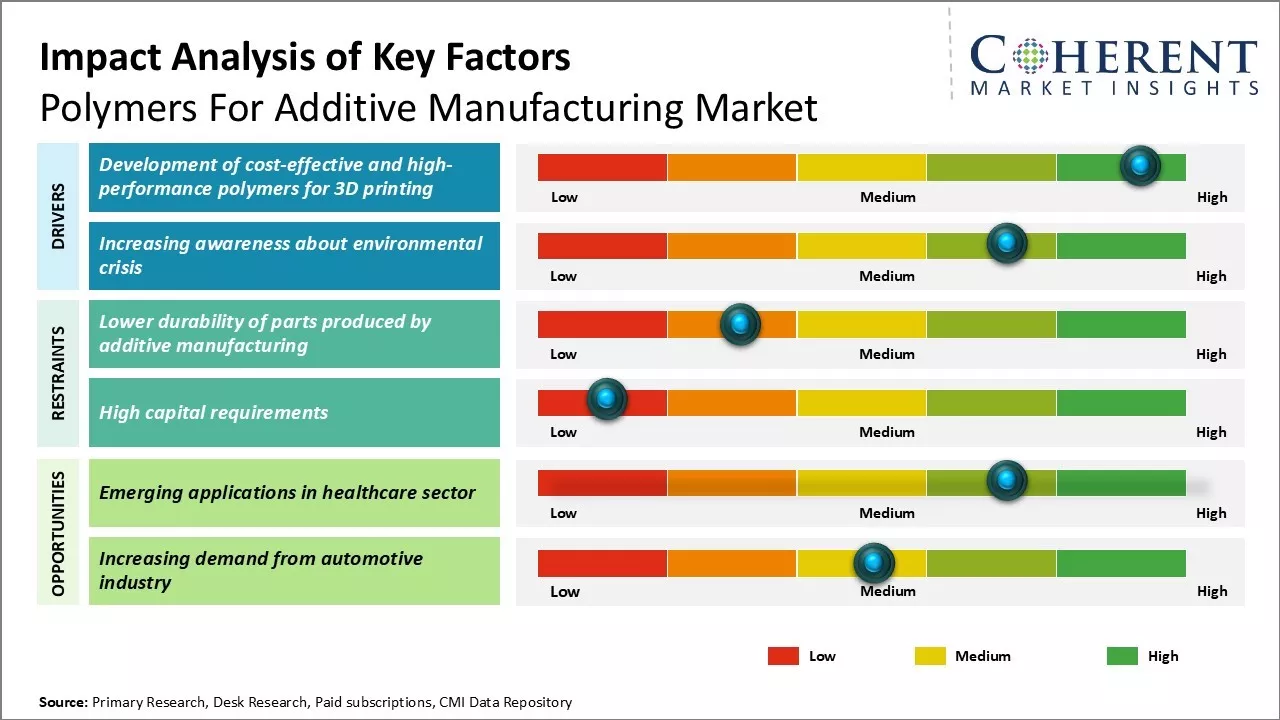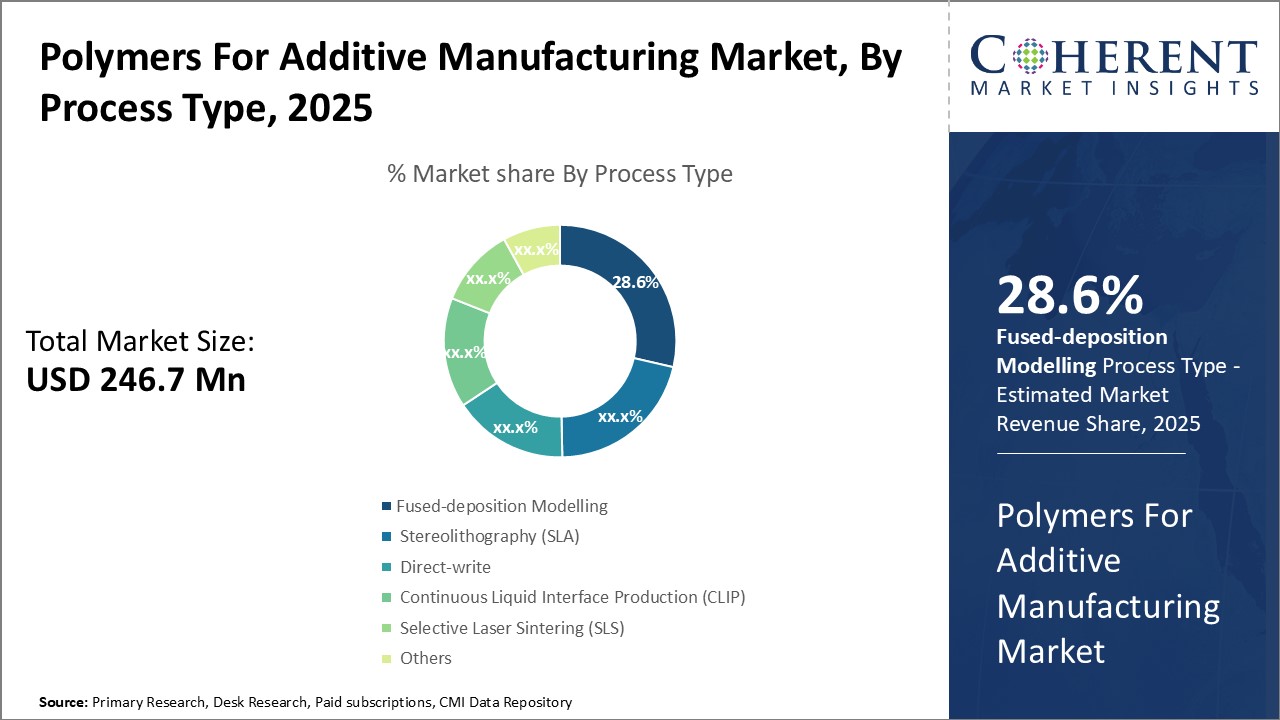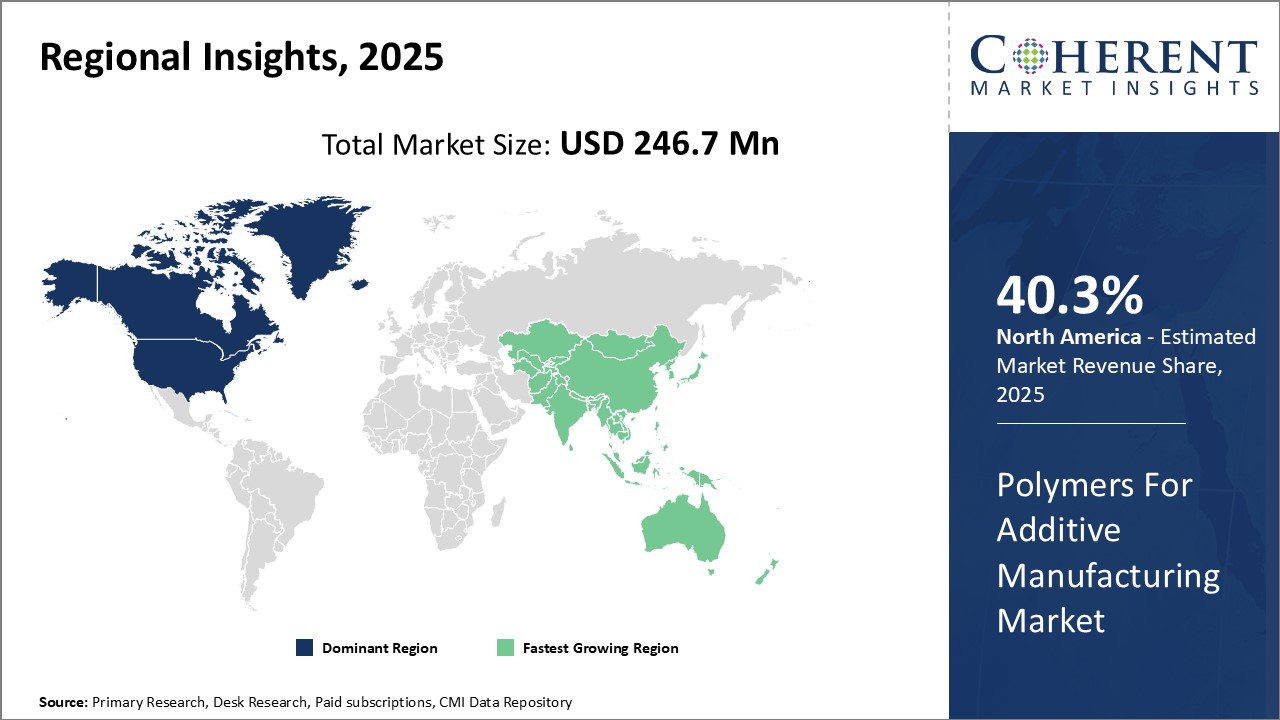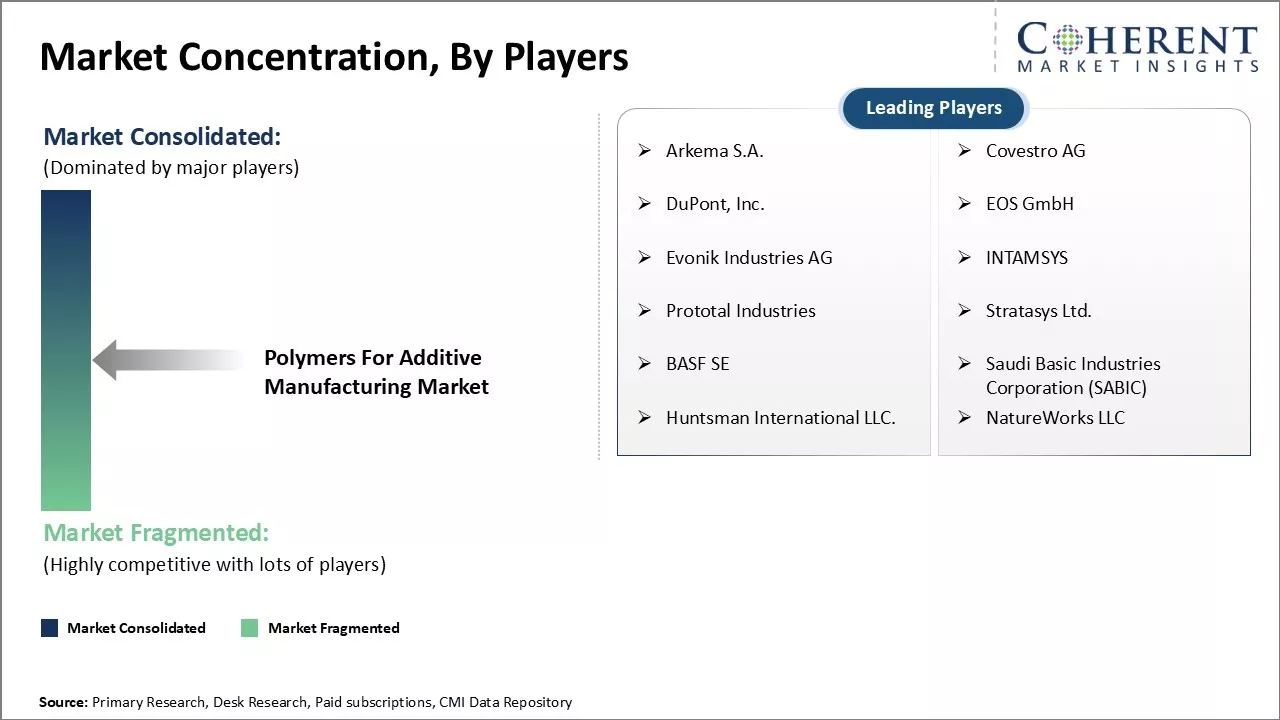
Polymers for additive manufacturing market is estimated to be valued at USD 246.7 Mn in 2025 and is expected to reach USD 959.3 Mn by 2032, exhibiting a compound annual growth rate (CAGR) of 21.4% from 2025 to 2032. The growing demand for polymers from different end-use industries such as automotive, aerospace, healthcare, and consumer goods is driving the market growth.

Discover market dynamics shaping the industry: Download Free Sample
The market is witnessing positive trends due to increasing adoption of 3D printing technologies across various industrial verticals such as automotive and construction. Rapid prototyping, mass production, and product design applications are driving the demand for polymers for additive manufacturing. Continuous innovation and development of new polymers suitable for 3D printing applications will present significant opportunities for polymers manufacturers and suppliers in the coming years.

Discover high revenue pocket segments and roadmap to it: Download Free Sample
Insights, By Process Type - Advantages of Precise Material Deposition Drive FDM Adoption
In terms of process type, the fused-deposition modelling (FDM) segment is estimated to contribute the highest market share of 28.6% in 2025, owing to its unique advantages over other processes. FDM works by extruding melted thermoplastic filament through a heated nozzle to deposit precise layers and build 3D objects. This allows designers to create highly detailed prototypes and end-use parts with intricate geometries and moving components that would be difficult or impossible to manufacture through conventional subtractive methods.
Insights, By Material - Superior Material Properties Drive Nylon's Popularity
In terms of material, the nylon segment is estimated to contribute the highest market share of 26.8% in 2025 due to its balanced properties that make it suitable for a wide range of engineering applications. Nylon filaments offer a unique blend of strength, toughness, fatigue resistance and environmental durability. They have high tensile and impact strengths combined with flexibility that makes nylon parts resistant to fracturing under mechanical stresses and continuous load cycling. Nylon's resilience stems from its polyamide chemistry that incorporates both hydrophilic and hydrophobic monomers into its molecular structure. The combination of hydrogen bonding forces and van der Waals attractions between chains gives nylon plastics resistance to cracks and crazes from repeated flexing. Its hydrophilic sites also enable nylon to absorb moisture without degrading mechanical properties like more brittle plastics.
Insights, By Application - Expanding Design Possibilities in Sensor Development through Additive Manufacturing
In terms of application, the sensors segment is estimated to contribute the highest market share of 47.8% in 2025, owing to additive manufacturing's ability to realize intricate sensor designs that were previously impossible. 3D printing empowers designers and engineers to embed functional sensor components, connectors and circuitry directly within structural parts during fabrication. This allows creation of fully integrated 'smart' products where sensing is an inherent part of the design rather than an external attachment.
Additive printing removes traditional size and shape constraints on sensor construction for unmatched design freedom. Ante-Meridiem (AM) makes it feasible to 3D print miniature, intricate sensors conforming to any geometry with embedded circuit paths leading to an interface. Complex multilayer sensor assemblies with interacting micro-components can be deposited simultaneously through a single production process.

Need a Different Region or Segment? Download Free Sample
Regional Analysis: Polymers for Additive Manufacturing Market
Dominating Region: North America
North America is expected to account for the greatest revenue share, with 40.3% in 2025. In North America, the dominance in the polymers for additive manufacturing market can be attributed to the strong presence of leading 3D printing technology companies such as 3D system and polymer manufacturers in the region. Countries such as the U.S. and Canada have established large 3D printing ecosystem comprising of original equipment manufacturer (OEMs), material suppliers and service bureaus.
Fastest-Growing Region: Asia Pacific
The Asia Pacific region exhibits the fastest growth due to rising foreign investments and expanding manufacturing sector across developing economies. Countries like China, Japan and South Korea are pouring investments to accelerate the industrialization of additive manufacturing. Large automobile and electronics industries rely on 3D printing for prototyping and specialized components production.
Polymers for Additive Manufacturing Market Outlook for Key Countries
US: The U.S. market is led by prominent companies like Stratasys, 3D Systems and ExOne focusing on new product development and acquisitions to strengthen their product portfolio and distribution networks.
Germany: Germany market is characterized by the presence of players like EOS and SLM Solutions pioneering metal additive manufacturing technologies.
China: China market is continuing to lead due to government initiatives promoting advanced manufacturing and ‘Made in China 2025' reform. Local players such as Xi'an Bright Laser are expanding aggressively.
Japan: Japan's market is influenced by major electronics manufacturer such as casio leveraging additive manufacturing for rapid prototyping in consumer product development cycles.

Get actionable strategies to beat competition: Download Free Sample
Top Strategies Followed by Polymers for Additive Manufacturing Market Players
Established Players focus heavily on R&D to develop innovative products. Companies like 3D Systems invest over 10% of annual revenue into R&D to stay ahead of the curve. They continually explore new materials like carbon fiber and polyamide composites with enhanced properties.
Strategic partnerships are also critical. For example, Stratasys has formed strategic partnerships with major automakers to develop application-specific thermoplastic materials. These partnerships allow them to gain industry insight while solidifying their position in key industrial sectors.
Market leaders also focus on global expansion. Companies like Arkema acquire regional polymer manufacturers to expand their international footprint. They recognize the need to locate production and R&D facilities close to industrial customers worldwide.
Mid-level players stay competitive by offering cost-effective solutions. Companies like BASF create polymer pellets and powders formulated for affordable 3D printing. Their economical materials allow more manufacturers to adopt the technology.
Collaborations are also a core strategy. Companies form joint research initiatives to bolster materials science expertise. For instance, Dupont partnered with HP to develop a versatile nylon powder for multi-material 3D printing.
Emerging Startups in the Industry
On the startup front, many focus on innovative technologies. For example, NewPro3D is developing a bio-based photopolymer resin made from sustainable soybean oil. Their eco-friendly material could reduce industry petrochemical dependence. Another startup, Polymaker, created Polymakers Polymax, a durable carbon-fiber enhanced nylon that pushes the boundaries of strength in 3D printed parts.
Sustainable solutions are also prioritized. Startup Biofil has created a marine bioplastic made from sustainably sourced red algae. Their material requires 70% less energy to produce than standard plastics. Meanwhile, researchers at Anthropic are using AI to design biodegradable materials like PHA with tailorable properties.
Startups additionally fill niche market needs. For instance, Materialise develops medical-grade thermoplastics approved for surgical implants and prosthetics.
Key Takeaways from Analyst
Polymers for Additive Manufacturing Market Report Coverage
| Report Coverage | Details | ||
|---|---|---|---|
| Base Year: | 2024 | Market Size in 2025: | USD 246.7 Mn |
| Historical Data for: | 2020 To 2024 | Forecast Period: | 2025 To 2032 |
| Forecast Period 2025 to 2032 CAGR: | 21.4% | 2032 Value Projection: | USD 959.3 Mn |
| Geographies covered: |
|
||
| Segments covered: |
|
||
| Companies covered: |
Arkema S.A., Covestro AG, DuPont, Inc., EOS GmbH, Evonik Industries AG, INTAMSYS, Prototal Industries, Stratasys Ltd., BASF SE, Saudi Basic Industries Corporation (SABIC), Huntsman International LLC., and NatureWorks LLC |
||
| Growth Drivers: |
|
||
| Restraints & Challenges: |
|
||
Uncover macros and micros vetted on 75+ parameters: Get instant access to report
Market Driver - Development of cost-effective and high-performance polymers for 3D printing
The 3D printing industry is embracing polymers as feedstock materials to manufacture complex shapes at a lower cost compared to traditional manufacturing techniques. With continuous advancements, polymer formulations suited for various 3D printing technologies are being developed. New polymer systems not only offer superior mechanical and thermal properties but also provide opportunities to print functional parts. For instance, in March 2024 the Federal Institute for Materials Research and Testing, or BAM predicts polyamides, polycarbonates, and PEEK will see increased use in additive manufacturing through 2025 as their properties are optimized for various manufacturing processes. The growth of specialized materials will further expand the capabilities and commercial viability of 3D printing. Researchers across the globe are engaged in discovering ingenious polymer compositions and structures to address challenges related to strength, flexibility, durability and other performance attributes.
Market Challenge - Lower durability of parts produced by additive manufacturing
One of the key challenges faced by the polymers for additive manufacturing market is the lower durability of parts produced through additive manufacturing as compared to traditionally manufactured parts. While additive manufacturing enables mass customization and produces complex designs with ease, the parts produced lack the same strength and durability as injection molded or machined parts. For example, as per tests conducted by the National Aeronautics and Space Administration (NASA) in 2021 on photopolymers used for 3D printing helicopter components, it was found that these polymers demonstrated 10-15% lower tensile strength compared to traditional machined components. The layered structure resulted in early failure along the interlayer interfaces under dynamic loading conditions.
Market Opportunity - Emerging applications in healthcare sector
The healthcare sector presents a major opportunity for growth in the polymers for additive manufacturing market. Additive manufacturing enables the custom design and production of medical devices, implants and prosthetics based on a patient's specific anatomy. This represents a paradigm shift from conventional ‘one size fits all’ model to personalized, custom fit solutions. Areas such as hearing aids, dental models, surgical guides and implants are increasingly adopting 3D printing. For instance, data released in 2021, according to projections by the International Society for Pharmaceutical Engineering, over 450,000 3D printed body parts will be implanted annually by 2030. The advances in healthcare 3D printing applications are likely to accelerate the growth of the polymer for additive manufacturing substantially. As patient-specific and tissue-engineered solutions become more commonplace, new opportunities will arise in line with developing 3D printing technologies and appropriate biomaterials.
Share
Share
About Author
Yash Doshi is a Senior Management Consultant. He has 12+ years of experience in conducting research and handling consulting projects across verticals in APAC, EMEA, and the Americas.
He brings strong acumen in helping chemical companies navigate complex challenges and identify growth opportunities. He has deep expertise across the chemicals value chain, including commodity, specialty and fine chemicals, plastics and polymers, and petrochemicals. Yash is a sought-after speaker at industry conferences and contributes to various publications on topics related commodity, specialty and fine chemicals, plastics and polymers, and petrochemicals.
Missing comfort of reading report in your local language? Find your preferred language :
Transform your Strategy with Exclusive Trending Reports :
Frequently Asked Questions
Joining thousands of companies around the world committed to making the Excellent Business Solutions.
View All Our Clients